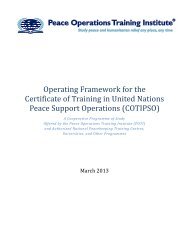the rise and rise of private military companies - Peace Operations ...
the rise and rise of private military companies - Peace Operations ...
the rise and rise of private military companies - Peace Operations ...
Create successful ePaper yourself
Turn your PDF publications into a flip-book with our unique Google optimized e-Paper software.
Hyder GulamHistory <strong>of</strong> Mercenaries - From <strong>the</strong> Magna Carta to <strong>the</strong> Coalition ProvisionalAuthority, Iraq 2004:Mercenaries existed in Engl<strong>and</strong> before <strong>the</strong> fourteenth century. The earliest writtenfinancial contract for <strong>military</strong> service is dated 1270. According to Terry Jones, <strong>the</strong>first knights who came across with William <strong>the</strong> Conqueror were <strong>the</strong>mselvesindistinguishable from mercenaries. These mercenaries <strong>of</strong>ten performed well <strong>and</strong>faithfully, but as soon as <strong>the</strong>re was any lull in activities, <strong>the</strong> hired soldier only too<strong>of</strong>ten became more trouble than he was worth. According to Jones, this is why, forinstance, Magna Carta in 1215 provided for <strong>the</strong> expulsion from <strong>the</strong> real <strong>of</strong> ‘all alienknights, crossbowmen, serjeants <strong>and</strong> mercenaries’. Thus, according to Chaucer, <strong>the</strong>growth <strong>of</strong> <strong>the</strong> mercenary soldier represented <strong>the</strong> general erosion <strong>of</strong> social values.Instead <strong>of</strong> obtaining peace, <strong>the</strong> mercenary was <strong>the</strong> cause <strong>of</strong> its effluxion.Across <strong>the</strong> English Channel, <strong>the</strong> early European use <strong>of</strong> organised mercenaries was in<strong>the</strong> form <strong>of</strong> <strong>private</strong> bodies in <strong>the</strong> 14th century known variously as Free Companies orGreat Companies. These organizations ultimately developed in Italy as condottieri(<strong>military</strong> contractors), who <strong>of</strong>fered <strong>the</strong>ir services to <strong>the</strong> highest bidder. The condottierisystem maintained fairly permanent <strong>companies</strong> <strong>of</strong> armed <strong>military</strong>. 46 The logic behind<strong>the</strong> condottieri system was simple <strong>and</strong> unquestionable: war being a barbaric pursuit,<strong>the</strong> citizens <strong>of</strong> a rich <strong>and</strong> flourishing state preferred to hire needy foreigners to fightfor <strong>the</strong>m ra<strong>the</strong>r than have to interrupt <strong>the</strong>ir own rich <strong>and</strong> pr<strong>of</strong>itable lives. Thisoccurred throughout <strong>the</strong> period <strong>of</strong> <strong>the</strong> Renaissance when civilization in Italy wasflourishing but Italy itself was divided into a number <strong>of</strong> rich <strong>and</strong> cultured states. Thesestates fought <strong>the</strong>ir wars against each o<strong>the</strong>r not with armies <strong>of</strong> <strong>the</strong>ir own citizens,considered an unthinkable waste <strong>of</strong> valuable lives – but with armies <strong>of</strong> mercenaries. 47Indeed, modern contractors resemble <strong>the</strong> <strong>military</strong> enterp<strong>rise</strong>s <strong>of</strong> <strong>the</strong> Renaissance. Asthis autonomous force ga<strong>the</strong>red momentum, <strong>the</strong> Courts <strong>of</strong> Europe grew alarmed <strong>and</strong>realized that <strong>the</strong>y would eventually have to act against this phenomenon. 48 It was <strong>the</strong><strong>rise</strong> <strong>of</strong> <strong>the</strong> State as an institution, monopolising violence, <strong>and</strong> it’s <strong>the</strong> entailingdevelopment <strong>of</strong> its own <strong>military</strong> <strong>and</strong> bureaucratic capabilities, that allowed <strong>the</strong> state tomore effectively control <strong>the</strong> projection <strong>of</strong> violence from its own territory, <strong>and</strong> hencecontrol <strong>the</strong> mercenary issue. This meant not only <strong>the</strong> state’s increased ability toexercise organised violence to suppress non-state violence beyond its borders but <strong>the</strong>augmentation <strong>of</strong> its capacity to control <strong>the</strong> activities <strong>of</strong> individuals within itsborders. 49 This led to <strong>the</strong> development <strong>of</strong> <strong>the</strong> Western tradition <strong>of</strong> <strong>the</strong> state, throughits monopoly over <strong>the</strong> legitimate use <strong>of</strong> force, being responsible for <strong>the</strong> provision <strong>of</strong>internal security <strong>and</strong> defence from external threats. 50As a corollary, <strong>the</strong> term ‘mercenary’ began to be coloured as a term <strong>of</strong> derision, wi<strong>the</strong>motive overtones. From <strong>the</strong> Middle Ages up to <strong>the</strong> 1980s mercenaries were arecognisable group <strong>of</strong> fortune hunters associated with particularly vicious actions.46 Eugene Smith, ‘The New Condottieri <strong>and</strong> US Policy: The Privatization <strong>of</strong> Conflict <strong>and</strong> ItsImplications’, Parameters, Winter 2002-03, 104 at 105.47 Anthony Mockler, The New Mercenaries, Sidgwick & Jackson London 1985, p.7.48 Op cit, fn.1 pp.13-15.49 Janice E. Thomson, Mercenaries, Pirates, <strong>and</strong> Sovereigns, State-building <strong>and</strong> ExtraterritorialViolence in Early Modern Europe, Princeton University Press 1994 p.90.50 Op cit, fn.7, p.5.Page 15The <strong>rise</strong> <strong>and</strong> <strong>rise</strong> <strong>of</strong> Private Military Companies
















